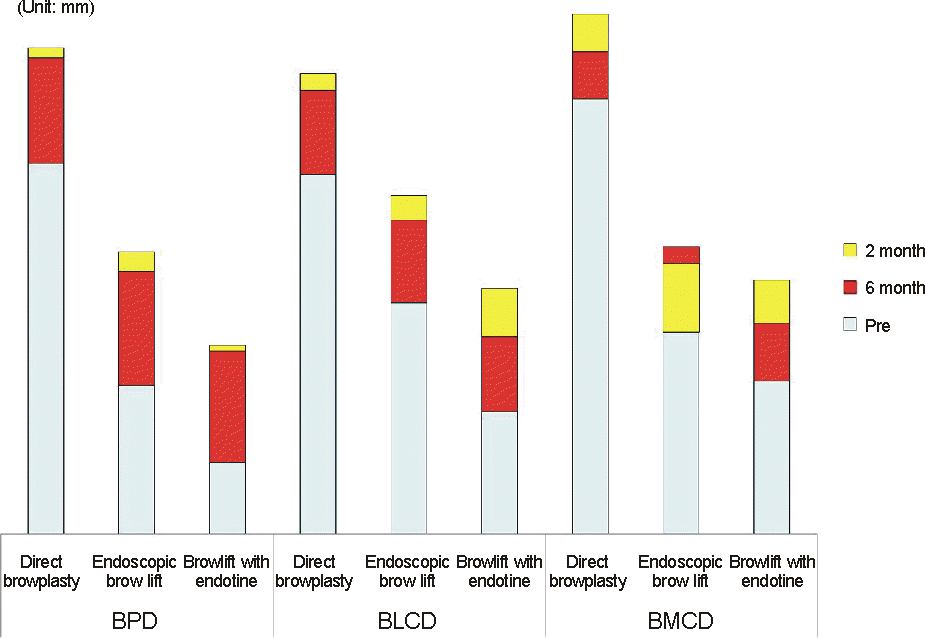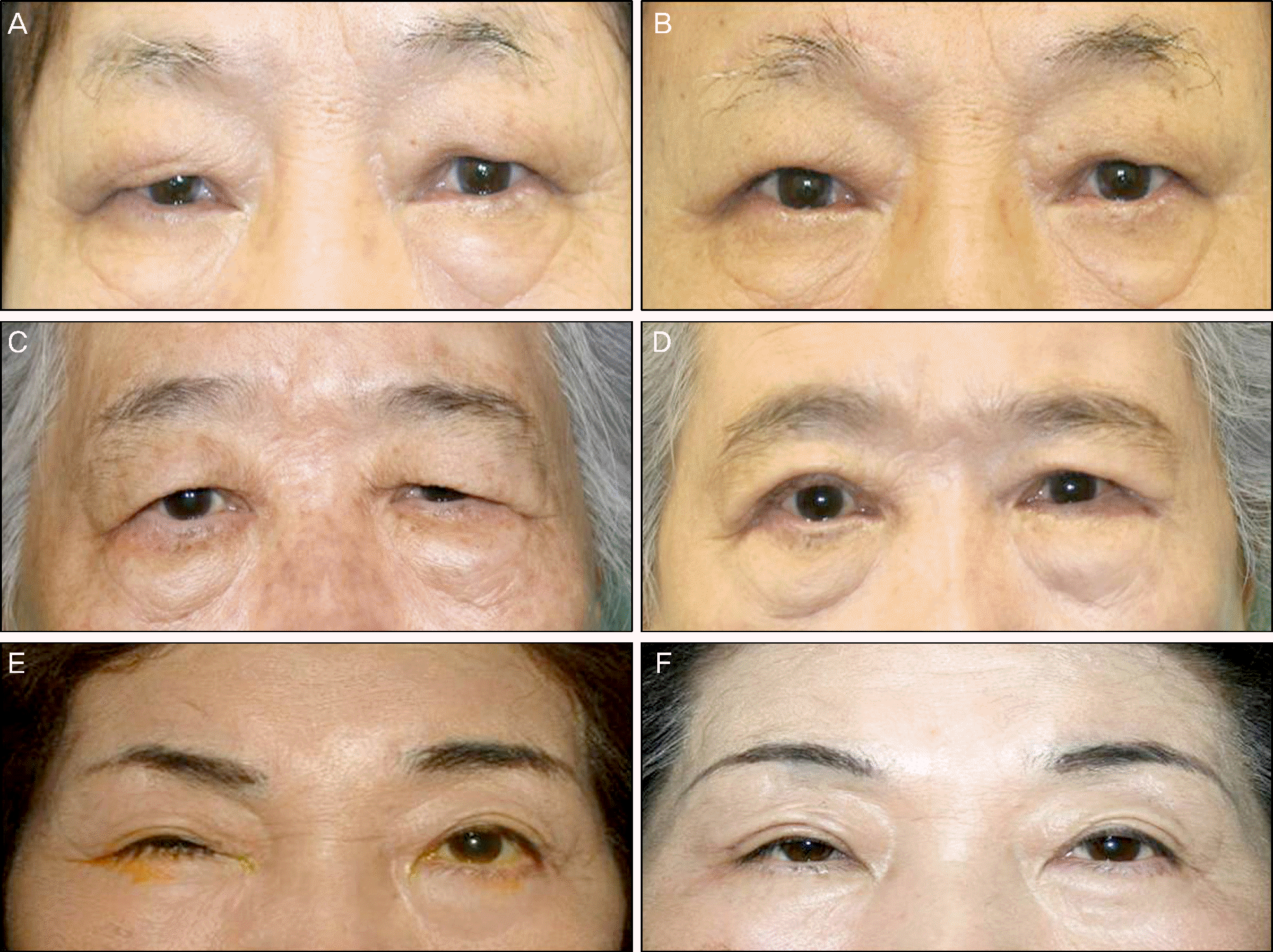Abstract
Purpose
The present study investigated the outcomes of browlift using various surgical methods including direct browplasty, endoscopic browlift and transblepharoplasty browlift.
Methods
Twenty-eight brow ptosis cases in 19 patients were treated in the present study. The mean patient age was 67.9 ± 9.7 years, and the mean observation period was 9.0 ± 3.8 months. Nine cases were treated with direct browplasty, eight cases with endoscopic browlift and 11 cases with transblepharoplasty browlift. Photographs of patients were taken before surgery and two months, six months and on the final follow-up after surgery. The brow-to-pupil distance (BPD), brow-to-medial canthus distance (BMCD), and brow-to-lateral canthus distance (BLCD) were analyzed by the Image J Program.
Results
BPD increased 1.88 ± 0.99 mm, BMCD increased 1.06 ± 1.21 mm and BLCD increased 1.36 ± 1.17 mm in all patients six months after surgery. Regarding the change in BPD, direct browplasty increased 1.79 ± 1.29 mm, endoscopic browlift increased 1.94 ± 0.80 mm and transblepharoplasty browlift increased 1.90 ± 0.94 mm without significant difference among the groups on the final follow-up. In terms of brow shape, direct browplasty effectively elevated the lateral brow and endoscopic browlift effectively elevated the medial brow compared to other procedures. No significant complications were observed in any patient.
Go to : 
References
2. Goldberg RA, Lew H. Cosmetic outcome of posterior approach ptosis surgery (an American Ophthalmological Society thesis). Trans Am Ophthalmol Soc. 2011; 109:157–67.
3. Czyz CN, Hill RH, Foster JA. Preoperative evaluation of the brow-lid continuum. Clin Plast Surg. 2013; 40:43–53.

5. Terella AM, Wang TD. Technical considerations in endoscopic brow lift. Clin Plast Surg. 2013; 40:105–15.

6. Costantino PD, Hiltzik DH, Moche J, Preminger A. Minimally invasive brow suspension for facial paralysis. Arch Facial Plast Surg. 2003; 5:171–4.

7. Rohrich RJ, Beran SJ. Evolving fixation methods in endoscopi-cally assisted forehead rejuvenation: controversies and rationale. Plast Reconstr Surg. 1997; 100:1575–82.

Go to : 
 | Figure 1.Schematic picture of the clinical parameters for the brow position measured in this study. The brow-to-pupil distance (BPD), brow-to-medial canthus distance (BMCD), brow-to-lateral canthus distance (BLCD), brow fat span (BFS), tarsal platform show (TPS) and interpalpebral fissure (IPF), were analyzed by the Image J Program. |
 | Figure 2.Comparison of clinical outcomes of brow position from patients with browptosis, before and after direct browplasty, endoscopic browlift and transblepharoplasty browlift with Endotine®. BPD = brow-to-pupil distance; BLCD = brow-to-lateral canthus distance; BMCD = brow-to-medial canthus distance. |
 | Figure 3.Comparison of time course of brow position from patients with browptosis, before and after direct browplasty, endoscopic browlift and transblepharoplasty browlift with Endotine®. BPD = brow-to-pupil distance; BLCD = brow-to-lateral canthus distance; BMCD = brow-to-medial canthus distance. |
 | Figure 4.Patients’ photos before and after various browlift surgeries. Direct browplasty: case of 70-year-old male patient (A: Before; B: After), endoscopic browlift: the case of 72-year-old female patient (C: Before; D: After), transblepharoplasty browlift with Endotine®: the case of 61-year-old female patient (E: Before; F: After). |
Table 1.
Clinical outcomes of brow ptosis patients treated with direct browplasty (n = 9)
| (mm) | Pre | Post 2 months | Difference | p-value* | Post 6 months | Difference | p-value* |
|---|---|---|---|---|---|---|---|
| BPD | 29.30 ± 5.12 | 31.27 ± 4.74 | 1.97 ± 1.45 | 0.011 | 31.10 ± 4.88 | 1.79 ± 1.29 | 0.008 |
| BLCD | 29.12 ± 3.85 | 30.83 ± 3.93 | 1.72 ± 1.17 | 0.011 | 30.55 ± 4.05 | 1.44 ± 1.35 | 0.021 |
| BMCD | 30.39 ± 5.45 | 31.84 ± 4.48 | 1.44 ± 1.23 | 0.015 | 31.21 ± 4.71 | 0.81 ± 1.19 | 0.110 |
| MRD1 | 1.34 ± 1.00 | 2.18 ± 1.09 | 0.84 ± 0.38 | 0.008 | 2.00 ± 1.02 | 0.66 ± 0.30 | 0.008 |
| MRD2 | 2.92 ± 1.38 | 3.16 ± 1.19 | 0.24 ±0 .41 | 0.139 | 3.12 ± 1.24 | 0.20 ± 0.46 | 0.139 |
| IPF | 4.26 ± 2.23 | 5.34 ± 2.06 | 1.08 ± 0.51 | 0.008 | 5.12 ± 2.15 | 0.87 ± 0.50 | 0.008 |
Table 2.
Clinical outcomes of browptosis patients treated with endoscopic brow lift (n = 8)
| (mm) | Pre | Post 2 months | Difference | p-value* | Post 6 months | Difference | p-value* |
|---|---|---|---|---|---|---|---|
| BPD | 25.52 ± 3.82 | 27.80 ± 4.20 | 2.29 ± 0.97 | 0.012 | 27.46 ± 4.14 | 1.94 ± 0.80 | 0.015 |
| BLCD | 26.93 ± 3.27 | 28.76 ± 3.44 | 1.83 ± 1.07 | 0.017 | 28.34 ± 3.63 | 1.41 ± 0.92 | 0.020 |
| BMCD | 26.44 ± 3.78 | 27.61 ± 3.47 | 1.18 ± 1.61 | 0.050 | 27.89 ± 4.50 | 1.46 ± 1.66 | 0.036 |
| MRD1 | 1.26 ± 0.65 | 2.50 ± 0.80 | 1.24 ± 0.58 | 0.012 | 2.46 ± 0.79 | 1.20 ± 0.60 | 0.012 |
| MRD2 | 2.86 ± 0.82 | 3.51 ± 1.08 | 0.65 ± 0.88 | 0.208 | 3.59 ± 1.29 | 0.73 ± 0.92 | 0.123 |
| IPF | 4.12 ± 1.19 | 6.02 ± 1.31 | 1.89 ± 1.20 | 0.012 | 6.05 ± 1.70 | 1.93 ± 1.34 | 0.015 |
Table 3.
Clinical outcomes of browptosis patients treated with transblepharoplasty browlift with Endotine® (n = 11)
| (mm) | Pre | Post 2 months | Difference | p-value* | Post 6 months | Difference | p-value* |
|---|---|---|---|---|---|---|---|
| BPD | 24.21 ± 4.86 | 26.21 ± 5.17 | 2.00 ± 0.62 | 0.003 | 26.11 ± 5.38 | 1.90 ± 0.94 | 0.003 |
| BLCD | 25.08 ± 4.71 | 27.17 ± 4.89 | 2.10 ± 1.36 | 0.003 | 26.35 ± 5.00 | 1.28 ± 1.28 | 0.004 |
| BMCD | 25.60 ± 4.56 | 27.32 ± 4.44 | 1.72 ± 1.19 | 0.003 | 26.57 ± 4.53 | 0.98 ± 0.82 | 0.004 |
| MRD1 | 1.73 ± 0.66 | 2.57 ± 0.50 | 0.84 ± 0.36 | 0.003 | 2.64 ± 0.65 | 0.91 ± 0.46 | 0.003 |
| MRD2 | 3.98 ± 0.99 | 4.24 ± 0.84 | 0.25 ± 0.49 | 0.168 | 4.04 ± 0.67 | 0.06 ± 0.50 | 0.790 |
| IPF | 5.71 ± 1.50 | 6.80 ± 1.14 | 1.09 ± 0.75 | 0.004 | 6.68 ± 1.18 | 0.97 ± 0.81 | 0.006 |




 PDF
PDF ePub
ePub Citation
Citation Print
Print


 XML Download
XML Download